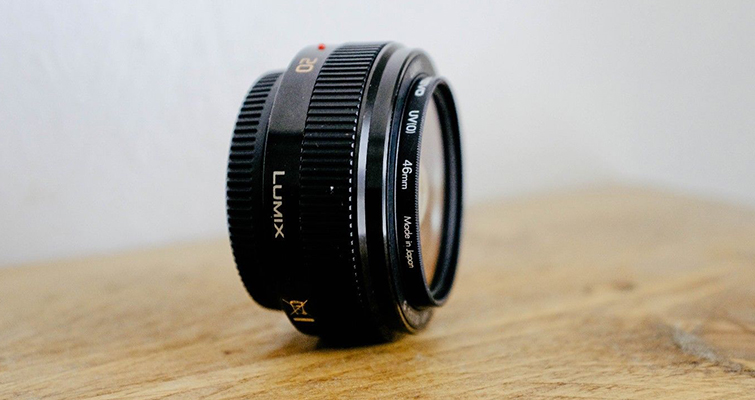
Gear Basics: Is Filming with a Pancake Lens a Viable Option?
What is a pancake lens, and should you be using one? In this write-up, we cover everything you should consider before attaching one to your camera.
When you’re first getting into filmmaking, the sheer amount of basic information you need to learn can be overwhelming. You may spend weeks learning how to capture audio correctly, only to discover that different microphones will have different polar patterns and capture sound differently — and the process starts over. The same goes for lenses. On a fundamental level, it can be easy to trip over something as simple as the terms for a lens. You can have a tilt-shift prime lens or a telephoto zoom lens with macro capabilities. If you’re new, it will get confusing quickly. Pancake lenses are no exception.
“Pancake” is the colloquial term-turned-commercial name for short-barreled lenses. They are usually no longer than 35mm, rarely over 40mm in focal length, and will commonly sit at f/2.8, but you can find faster lenses on the market (the lens in the cover photo is a 20mm f/1.7). In regards to price point, they sit on the edge of the budget-friendly market, averaging about $200. The faster and better-built pancake lenses will, of course, increase the price and land at the bottom end of the intermediate market.

How will it change my images?
So, what exactly will a pancake lens do to your image? Will it flatten the image? Will there be a sweeping barrel distortion? No. A 20mm pancake lens will produce the same image as a 20mm full-sized lens (minus the disparity in the quality of the lens elements). A pancake lens is, for all intents and purposes, just a thin lens. That’s it. A short-barreled lens. It can be a thin prime, such as a Canon 24mm, or a small zoom, like the Olympus 14-42mm. But it will not alter the way that light travels through the lens to the sensor. Very few companies market short-barreled lenses as pancake lenses. The B&H listing may reference the lens as a pancake shape, or Amazon presents a variety of lenses when you search for “pancake lens,” but you’ll often find that the majority are not titled as such.
Can I use One For Filmmaking?
The quality of the pancake lens comes down to brand and glass. They are, after all, budget lenses, so don’t expect world-class glass. Further, the electronic functions like the autofocus and aperture changes are going to be clunkier than you’d see with a higher-end lens.
That said, how are these as filmmaking lenses (there’s nothing to say that you can’t use them as such). In fact, the following travel video is the product of a pancake lens, and it looks beautiful.
Of course, the most notable aspect of the lens is the size. As a result of its compact nature, we don’t get a focus ring to grip. Depending on the brand on the lens, you’re only going to have a focus ring at around 5mm, at most — if that. Canon and Nikon pancake lenses are quite notorious for very small focus rings on budget lenses.

If you use a follow focus or like to pull focus with your fingers on the focus ring, you’ll find focusing impractical — but not impossible. You can find accessories to help with focus pulling, such as the DSLR Solutions Follow Focus. However, I often find that adding additional pieces of equipment to a tool designed to be compact defeats the purpose of buying that tool in the first place.
I wanted a smaller lens to take with me when galavanting around the coast, and as a previous owner of a Canon pancake lens, I was worried about the lack of focus ring handling. However, the Panasonic 20mm 1.7 has quite a thick focus ring, making it very practical for manual focus. In the case of the 20mm, it actually accounts for at least half of the overall length of the lens itself. So, they are out there; they just require a bit of searching.

Secondly, since the lens is compact and discreet, it’s not going to be the same quality as a Canon L series. The lens is going to feel light and cheap, and while some pancake lenses do have a metal housing, more often than not, they’ll be plastic. They also can’t resist accidental force like a more expensive lens. Conversely, due to the size and weight, dropping one will have less impact than dropping a heavy lens. (It is, of course, recommended that you avoid dropping lenses.)
Finally, and while this shouldn’t matter if the images you’re capturing are good, some inexperienced clients think larger equipment automatically yields better results. Therefore, showcasing a DSLR with a “toy-like” lens may fail to impress and cost you the job. But, if you’re only just buying your first lens for your first camera, let’s not rush into job searching just yet.
Conclusion
Ultimately, once you remove the commercial branding, a pancake lens is a budget prime or zoom lens. Whether that lens can capture sharp and vibrant images is up to the lens critics. But in regards to filmmaking, while it’s still a viable solution for vlogging and travel videos, for any kind of narrative work, the inability to wrap your fingers around the focus ring or attach a follow focus means this lens is not a suitable choice.
Looking for more info on lenses? Check out these articles.






